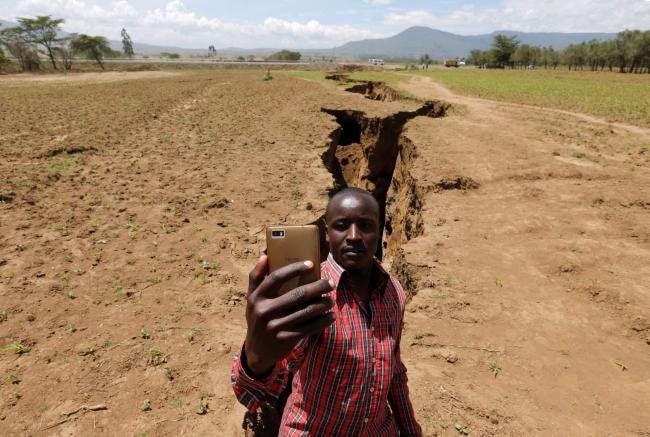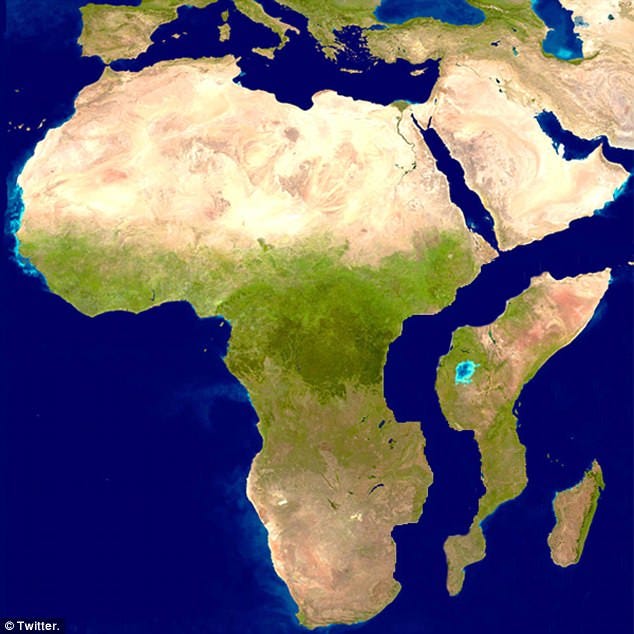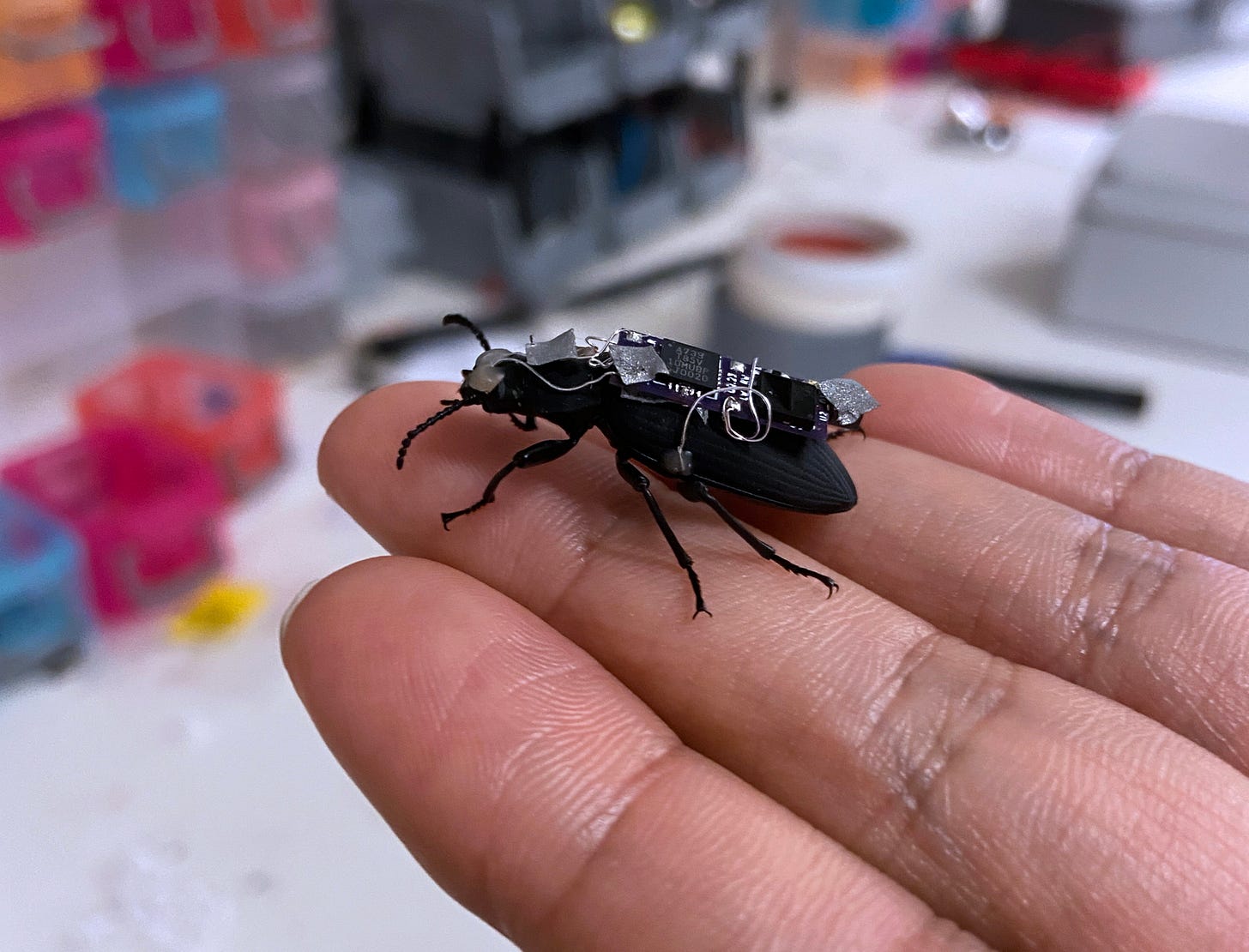The Weird Science Drop #12 🌎 Spin me right round, baby, right round
🚀 Space cannabis falls to Earth 💊 Live a little longer and you'll live forever 🐬 Dolphins not coming back 🐜 Plus, China invents Ant-Man spy drone
“Hola compañero!* There are never enough hours in a day, or so people often complain. And this summer there’ll be a day when that’s never been more true as the Earth’s spin is speeding up. This week on TWSD, we also look at a creature that is both alive and not alive, the upcoming singularity, and why Africa is splitting into two. Read on and don’t forget to hit that subscribe button!”
Daniel
*Howdy partner in Spanish
Q: Why did the germ cross the microscope?
(answer at the bottom of the email)
Weird Science News ✍
⏰ Days are getting shorter - and scientists don’t know why. Over the past five years, our planet has been spinning around faster than usual. So much so that this summer we’ll see the shortest day since records began.
Now this might well be by less than a blink of an eye, but it would be good to know what is going on and why. The Earth has been on a rollercoaster ride and until recently it had been spinning slower than normal due to the friction of the tides caused by the Moon’s gravity.
Our rocky pal is also the main suspect for the sudden speed-up, as its distance from us isn’t fixed and ‘wobbles’ a wee bit.
What is amazing to think about is the 24-hour day we know and love wasn’t always so. Back when the Moon was formed and much closer to the planet, a day on Earth lasted just three hours! Read more on Union Rayo
🦟 Just like Ant-Man, China is going small. A defence research institution has just revealed a spy drone closely resembling a mosquito that’s just 2cm long and weighing 0.3 grams.
The insect-inspired device features two tiny wings that can flap 500 times a second and three spindly legs, and is small enough to get past any enemy radar system.
The bionic ‘microdrone’, showcased on China’s state-run military broadcaster, is packed with sensors intended for covert surveillance and other military operations.
Liang Hexiang, a student at the National University of Defence Technology, said:
“Here in my hand is a mosquito-like type of robot. Miniature bionic robots like this one are especially suited to information reconnaissance and special missions on the battlefield.”
Other countries are also fans of the MCU, with the US Department of Defence’s secretive DARPA lab launching a project named Hybrid Insect Micro-Electro-Mechanical Systems to create ‘insect cyborgs’ by placing micro-mechanical systems inside the insects. Read more on Euronews
🦠 Now this is something you don’t read every day. Scientists have discovered a new creature that exists in the twilight between life and, well, not quite death, but non-life. To be fair, as a father to two young boys, I can relate to that feeling.
It gets even stranger: a newly discovered organism appears to straddle the line between a virus (non-life) and a cell (definitely alive).
Viruses are downgraded in the eyes of biologists because they don’t do the things that living cells can do like grow, reproduce on their own, or make their own energy. Of course, that doesn’t mean they cannot bring the world to its knees if they wanted (ahem, Covid).
And now Japanese scientists have come across ‘Sukunaarchaeum mirabile’ - an entity that uses a little from Column A and a little from Column B. Read more on Popular Mechanics
🚀 Sad to report that a space cargo of human remains and cannabis has been lost at sea after a German mission on top of a SpaceX rocket went awry on the way down.
The Nyx capsule, created by startup The Exploration Company, was carrying ashes and DNA of more than 166 deceased people provided by Celestis, a Texas-based memorial spaceflight company, plus cannabis plant matter and seeds provided by a citizen science project.
Describing the mission as a ‘partial success (partial failure)’ - a guess that depends on whether you’re more of a glass-half-full or a glass-half-empty type - the capsule achieved orbit and controlled reentry before the parachutes failed to deploy. Celestis told the bereaved;
“We hope families will find some peace in knowing their loved ones were part of a historic journey, launched into space, orbited Earth, and are now resting in the vastness of the Pacific, akin to a traditional and honored sea scattering.”
The cannabis joined the ride as part of a study to see if it could grow on Mars. After all, life on Mars might get a little dull without something green to grow. Read more on Science Alert
🌍 Africa is breaking up - and it’s happening right in front of our eyes. The continent has a 6,000km-long rift running from the Red Sea to Mozambique that has been pulling apart for millions of years. And what’s so unusual about it is that we can actually see it.
The Horn of Africa region - Somalia, Ethiopia, and Kenya - is slowly pulling away from mainland Africa at rates varying from several millimeters to centimeters annually. But in 2005, a dramatic acceleration saw a 2m-wide, 60km-long fissure open up in western Ethiopia in just a couple of minutes - an event that normally takes centuries.
This growing tectonic rift will one day create a new sea in a similar way that the Atlantic formed when Africa and the Americas went their separate ways. The Horn of Africa will end up being one great big island. Read more on Evidence Network
Rise of the robots and cyborgs 🤖
💻 Everything is AI these days, even when it’s really nothing more than predictive text on steroids. But this doesn’t mean we aren’t hurtling towards something futurists (what a job!) call the singularity.
This is the moment when a real AI emerges, one that is self-aware and more than probably decides to kill us all like Skynet from the Terminator movies.
For decades, the daddy of the singularity has been American computer scientist Ray Kurzweil, who has long been saying we’ll get there by 2029.
Many critics scoffed at the idea at the time but you’d forgive Ray for being a little smug these days. In his latest book he has doubled down on his claim, and now predicts that - if we survive - by the middle of the century we’ll achieve ‘millionfold intelligence’.
This is when humans will merge with nanobots to become a mix of natural and cybernetic intelligence. Such a cyborg would redefine what it means to be human.
Indeed, society will have to change to keep up. Kurzweil is up for a Universal Basic Income (or maybe we can do away with money altogether like in Star Trek), as we’ll get to a point when you’d never die from old age or disease.
So, if you’re young enough, I’d circle 2045 on your calendar. If you’re still around then - and, I’m guessing, rich enough - you could be in for the long haul.
Talking of robots, Business Live got a glimpse of the future thanks to a tour of Amazon’s super hi-tech Japanese distribution centre and people were in short supply. Instead, it’s dominated by Hercules robots each strong enough to carry a concert grand piano.
DIY Gulf Stream plan could save Europe and the eastern US 🌊
Shipping tankers, drones and fishing boats could be used to drag giant parachutes through the waters of the Atlantic Ocean as part of a plan to combat catastrophic climate change.
Climate scientists are very worried that the Atlantic Meridional Overturning Circulation (AMOC) is about to collapse - and that won’t be good for anyone. The phenomenon drives the Gulf Stream and brings warm water from the tropics northwards, keeping Europe nice and toasty.
If it were to go belly up, temperatures where I am would drop by around 15 degrees Celsius, the sea level off the coast of the eastern United States would rise alarmingly, and the US would be in line for some super-powerful hurricanes.
As we don’t want any of this, researchers are looking into the possibility boats could tow huge underwater parachutes around the ocean to manually power the current.
It sounds a little crazy but they reckon we’d need just 30 vessels to keep things going.
Professor Stuart Haszeldine, of the University of Edinburgh, and David Sevier, founder of water treatment Strengite, presented the idea at the Arctic Repair conference in Cambridge this week. Prof Haszeldine said:
“We think that this is a remedy well worth trying - because we want to keep the flows of ocean current similar to what we know works well just now.”
Photo of the Week 📷
Bugs with backpacks could help search and rescue teams locate survivors. Researchers say that by equipping common beetles with microchip backpacks victims could be found within hours instead of days following disasters such as building and mine collapses. University of Queensland scientists have shown they can remotely guide darkling beetles fitted with the packs via video game controllers. The backpacks prompt movement in specific directions through electrodes that stimulate the insect’s antennae or hardened forewings known as elytrons.
For your eye holes 👀
Mathematicians have created a pyramid-like shape (called a tetrahedron) that always reverts to the same side no matter how you place/drop it. Watch the video, you’ll find it very relaxing!
Infographic Magic 📊
Cool Quote 🗣
“Progress is made by trial and failure; the failures are generally a hundred times more numerous than the successes, yet they are usually left unchronicled.”
William Ramsay
Weird Science Factoid 🤯
You travel 2.5 million km a day around the Sun without realising it and 19 million km with respect to the centre of the Milky Way. So never say you’re not going anywhere. Although technically, you are going around in circles.
Weird Science Fries on the Side 🍟 (aka the best of the rest)
🐱🐉 Archaeologists have found prehistoric art carvings right next to fossilised dinosaur footprints in Brazil. It’s believed the artists from some 9,000 years ago were using the 66-million-year-old prints as a source of inspiration.
🤿 Dive deep enough and you never know what you might come across. And now we might well have found the blueprints for the human body way down at the bottom of the ocean.
🐱👤 If you have a spare £3million, you’ll be in with a chance of winning a piece of another world. The largest Martian meteorite ever found on Earth is up for auction after being found in the Sahara Desert two years ago.
🐬 Dolphins and orcas used to roam the land before jumping into the sea -and they’re not coming back. New research has shown the marine mammals have passed the point of no return in their evolution.
👩🔬 In a rather worrying development for us pessimists, researchers have successfully reawakened microalgae that have remained dormant for nearly 7,000 years in the sediments of the Baltic Sea.
Did you miss? More from The Weird Science Drop 👀
A wonder from the deep
Bad dreams can kill
Retro flying
The most-visited links from the last newsletter 👇
Mars Rover Snaps First Detailed Photos of Giant ‘Spiderwebs’
Scientists rethink animal consciousness: Reptiles, fish, and insects may be sentient
About The Weird Science Drop 🚀
Science is weird, and here’s the proof. The Weird Science Drop goes where other, more-sensible newsletters fear to tread. Every week, we grab our trusty white lab coat, bunch of bubbling test tubes and world-ending robot prototype to go in search for the overlooked, under-the-radar and, above all else, most madcap science news, views and research.
About me 👴
Daniel Smith is an old experienced journalist who has worked for a host of news publishers on both sides of the Atlantic. A long, long time ago, he fancied himself as an astrophysicist but instead turned out to be the worst scientist since the man who mapped out all those canals on Mars that turned out to be scratches on his telescope's lens. Luckily, he is now not working on the Large Hadron Collider inadvertently creating a black hole that would swallow the world by pressing the big red button but is safely behind a desk writing this newsletter, bringing you the fantastical underbelly of nature... The Weird Science Drop.
Have I missed anything? 🚨
Feel free to throw me an email or just fill out this super simple form. I'll read each and every one. Promise.
Joke answer: To get to the other slide!









